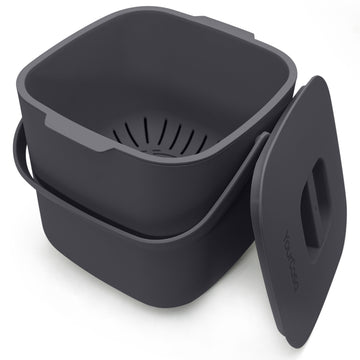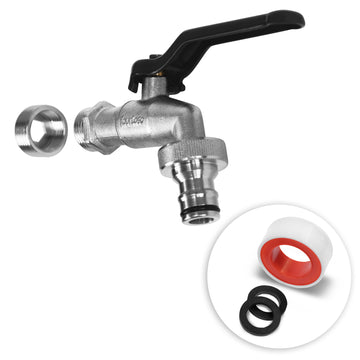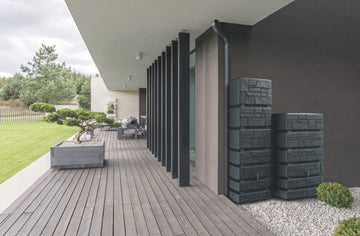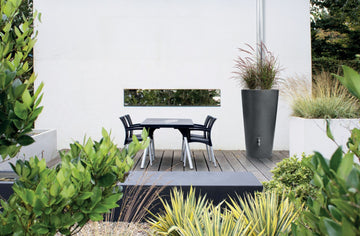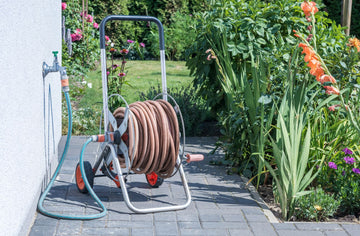
Since 2016, we at YourCasa have been enriching the market for premium garden accessories with our rain barrels and the like Accesories . With our products you can not only beautify your garden, but also contribute to environmental protection and noticeably reduce your high water bill.
How can you reduce your water bill with rainwater harvesting? By using rainwater in your own garden and household, you can significantly reduce the cost of your water bill. Collected rainwater can be used in many ways: for watering the garden, washing cars or even as water for the toilet. As a result, you use less tap water and inevitably lower your water bill.
We will explain to you how you can collect and use rainwater efficiently – and thus save money on your water bill.
Advantages of rainwater harvesting
Using rainwater offers numerous benefits. You will quickly notice that not only does the environment benefit from switching to rainwater, but so does your bank account. Using rainwater allows you to save significant costs . By using rainwater for everyday tasks like watering your garden, washing your car, or even flushing the toilet, you can significantly reduce your use of costly tap water. This, logically, leads to a noticeable reduction in your water bill.
In addition, by using rainwater you make a significant contribution to environmental protection. Rainwater is a natural and renewable resource that, unlike treated tap water , no energy consumed. Untreated rainwater is even better for your plants than treated tap water because it is free of chlorine and other chemicals and is therefore generally more tolerable for plants.
In times of rising costs due to inflation and crises as well as growing social pressure for environmental protection, the advantages of rainwater use should not be underestimated - and we will summarize them again for you:
| Advantage | Description |
| Cost savings | By using rainwater you can immediately significantly reduce your water bill. |
| environmental Protection | When you use rainwater in the garden and at home, you conserve water resources and reduce energy consumption because tap water does not need to be treated. |
| sustainability | You can take a big step towards more sustainability in your household by using rainwater. |
| Better for plants | Rainwater is often better for plants because it is free of chlorine and other chemicals found in tap water. |
| Easy integration and maintenance | YourCasa rainwater collection systems are easy to install and maintain. |
| Aesthetic aspects | The rain barrels from YourCasa are not only extremely practical, they also spice up your garden. |
Setting up a rainwater collection system
The first step in setting up your new rainwater collection system is choosing the right accessories. At YourCasa you will find high quality Rain barrels . When choosing your rain barrel, pay particular attention to the following factors: size, material and design. With us you can choose between a wide variety of models, so you are sure to find the right one.
When making your purchase decision, consider the annual rainfall in your region and the roof area of your house, among other things. The more it rains and the larger the potential collection area, the larger the capacity of the bin you purchase should be .
After selecting the right rain barrel, installation follows. You can usually tackle these yourself and without any professional help. Typically, you should place the rain barrel on a downspout that directs rainwater from your home's gutters directly into the barrel. Make sure that your rain barrel is stable and possibly equipped with an overflow protection. In order to keep your bin clean in the long term, it also makes sense to install a filter that catches leaves and dirt.
Maintaining a rainwater collection system is surprisingly straightforward. It is only important to clean the bin, the downpipe and the gutters regularly. You should also empty the collection system completely before the onset of winter to avoid frost damage.
Here is an overview of the procedure again:
- Choose the right accessories, such as the rain barrel. Pay attention to factors such as the amount of precipitation and the collection area.
- Install the rain barrel and accessories in the correct location, usually under a downspout.
- Make sure your bin is stable.
- Optionally install a filter.
- Maintain your system regularly.
Rain barrels and water bills: cost-benefit analysis
Purchasing a rain barrel from YourCasa doesn't seem to be that cheap at first glance. You may be wondering why you should n't just buy a cheap alternative . We can tell you why you shouldn't do that: Buy quality now and you'll still have something from it in a few years and decades.
And not only that. By using a YourCasa water butt for irrigation and other household purposes, you can make significant savings on your water bill. Let's put the whole thing into perspective:
Assume that your rain barrel is completely filled on average once a week during the rainy season. This results in a collection volume of approximately 10,920 liters of rainwater per year (210 liters * 52 weeks for the best-selling model ). At a price of €2 per cubic meter of tap water, this corresponds to an annual saving of around €21.84. The savings add up over the years - and after just a few years you can reap significant financial benefits from your YourCasa rainwater collection system.
Also keep in mind that in many regions water is always becomes scarcer. Although Germany has not yet been particularly affected by this development, it is only a matter of time before water shortages become a serious problem here too. By then you will have to expect rising water prices - and you will be happy that you are at least partly independent of the municipal water supply systems.

Environmental benefits of rain barrels
Environmental protection is becoming more and more important and present in the minds of many people. One thing is clear: the use of rainwater in the garden and in the household contributes significantly to reducing your water footprint and thus protect the environment.
Using rainwater for everyday tasks like watering your garden and washing your car automatically means that less drinking water is needed for these purposes. Since the treatment and distribution of drinking water is usually quite energy-intensive and emits a lot of CO₂, every liter of rainwater collected helps reduce CO₂ emissions.
Additionally , the use of rainwater supports local ecosystems . Rainwater is more natural and softer than treated tap water - and therefore much better for the health of soil and plants.
Integrating a rainwater collection system into your household is a simple but effective method of actively contributing to environmental protection - and in the following table you can read at a glance why:
| Environmental benefit | Description |
| Reducing your water footprint | When you reduce your water consumption, you help reduce the strain on community water systems, thereby reducing your water footprint. |
| Reducing your CO₂ emissions | Also hand in hand with reducing your water consumption is reducing your CO₂ emissions, as water treatment plants emit a lot of CO₂. |
| Supporting local ecosystems | Rainwater is softer and more natural than treated tap water and promotes the health of plants and the quality of the soil in your garden - which also appeals to animals such as bees and birds. |
Practical tips
Simply collecting rainwater is all well and good - but you should also use the collected water consciously and efficiently . We give you tips and explain how it works.
Above all, make sure to use rainwater as needed . Find out how much water your plants need and give them only that amount of water. If you water your plants too often or with too much water, it can actually be harmful to them - and in the worst case, the plants will die permanently. There are irrigation systems such as drip hoses that allow you to deliver metered water directly to the roots of your plants.
Another practical tool is an overflow protection. Basically, it refers to a hose that protects your rain barrel from overflowing during heavy rain. This can result, among other things, in the outside of the barrel becoming dirty and the area around the rain barrel becoming overwatered. This can cause damage to the floor. The overflow protection ensures that this does not happen. You can even use hoses to direct the excess water directly to certain areas of your garden - for example, to areas where rainwater does not normally reach.
Last but not least, don’t forget to take care of your rainwater collection system . Check regularly whether the inside of your bin is dirty, whether there is algae forming or whether the gutters and supply lines to the bin are blocked.

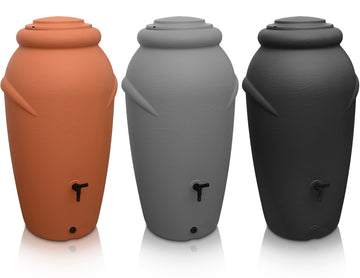
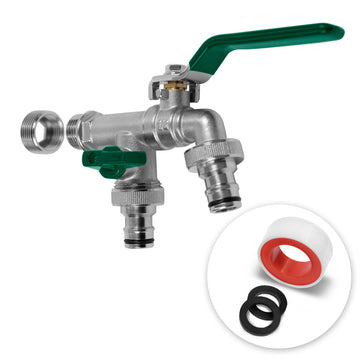
![Drei hohe YourCasa Regentonne 240 Liter [Wellen-Design] - Frostsicher & UV-beständige Gartentöpfe in den Farben Schwarz, Grau und Terrakotta, jeweils mit Drainagesystem für nachhaltige Bewässerung.](http://yourcasa.de/cdn/shop/files/ohnelogo_b8aeecac-557e-4106-a999-e77dcd160209.jpg?v=1707130230&width=360)
